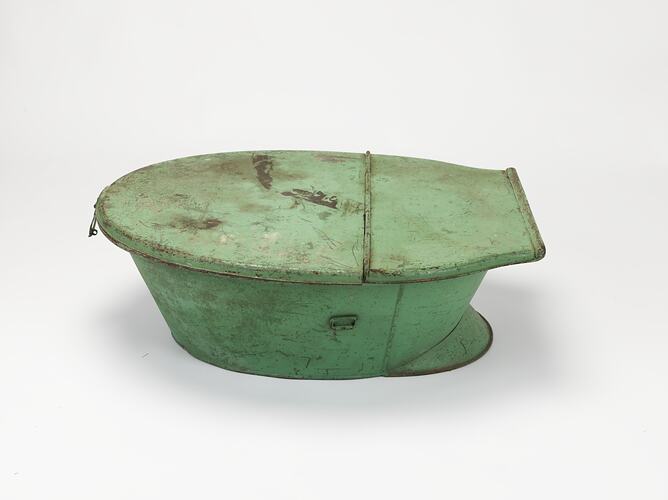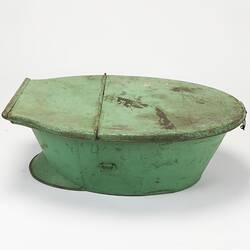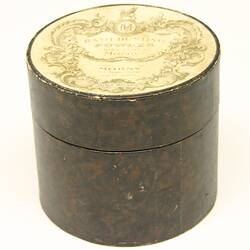The eighteenth and nineteenth century Industrial Revolution transformed almost every area of English life, and everyday objects reveal not only economic but social change. As cause and consequence, Britain's once manual, laboured-based economy was replaced by industry and manufacturing. The influx of rural English and Irish migrants (particularly after Ireland's 1846-7 famines) into the larger cities resulted in rapid population growth. In England and Wales the population grew from 5.7 million in 1751, to 8.7 million in 1801 to 16.8 million by 1851 (Morgan, 2004: 23). This expansion was most evident amongst the urban dwellers where the population more than doubled from 21% in 1750 to 45% a century later (Horn, 2007: 5). Although population numbers grew in parallel with production increases, the wage falls of 1760-1780 ensured that most gains within living standards did not appear until 1830-1840 (Horn, 2007: 5). Industrialisation marked a historical turning point, and amongst these massive changes were attitudes towards class and hygiene, whereby 'cleanliness' was equated with respectability and 'smell' was an indicator to health, class and social order.
Offensive odours were part of everyday urban living and these smells acted as indicators to health and social order. Environmental pollution was the by-product of industrialisation. Coal production created waste products such as soot, ash and various gases; chimneys deposited sulphur compounds; steam engines produced smoke; the 'dirty trades' including slaughterhouses washed their debris (animal blood and guts) onto the street; overcrowded urban graveyards emanated with the smell of rotting corpses dug up to make way for new ones; and in the early nineteenth century bucket privies, dung carts and cesspits were common methods for disposing of human waste (Morgan, 2004: 25). Environmental pollution found within the atmosphere and water supplies, combined with poor living conditions, ensured that life-threatening diseases such as small-pox, measles, cholera (at epidemic proportions in 1832 and 1848) remained a vigilant part of everyday concerns for all classes - in particular the working class. However, paradoxically in the 1840s, without the use of modern technology and equipment, scientific ideology located disease as being a miasmic contagion (Halliday, 1999: 17). That is, good or bad health resulted from the properties being inhaled into the lungs. Consequently, smell became the means to identifying unhealthy living, and thereby, social identity.
Industrialisation brought new concerns and fashioned new habits regarding dirt and disorder. As a consequence, cleanliness became a moral and social criteria rather than one of mere hygiene (Davidoff and Hall, 2002: 382), and subsequently, an indicator to moral and social standing. For the Victorian middle classes, united by their strong sense of respectability, sobriety and good manners, their homes were the centre of their existence (Eveleigh, 2002: 64) and cleanliness a marker to their social qualities. In Victorian homes women and servants fought with pollution, as domestic objects such as carpets, curtains, canopied beds and soft chairs harboured more dirt than the previous traditional wooden furniture. The presentation of cleanliness was a moral duty so 'creating a routine of regular bath time for the family was an expression of middle-class values: it was an effective way of promoting good health, cleanliness - and therefore respectability - and perhaps even, if the water was cold, character training.' (Eveleigh, 2002: 64)
The connection between odour, respectability and health is synonymous with all social classes, but as pleasant smells signified middle and upper classes, so too did unpleasant smells equate to the lower classes. For in a time when the middle ranks used soap for laundry, many labourers' families still used urine to disinfect their clothes. Given their resources the gap between personal hygiene of lower classes and the moderately well-off was widening (Davidoff and Hall, 2002: 382). Subsequently, offensive odour had become an element within maintaining social hierarchy (Davidoff and Hall, 2002: 382); one could use their nose to determine their immediate environmental hazards. 'Cleanliness, like good manners became an indicator of respectability while dirt and squalor were seen as threats to moral as well as physical health' (Everleigh, 2002: 65). However, this notion of 'cleanliness' equating to 'social respectability' was not just a phenomenon found on English soil, but also extended to English travellers and their travels.
'Cleanliness' was a key component within the English national identity as imagined by middle and upper class men and women. When travelling, habits such as manners, recreational pursuits, methods to ensure personal comfort, and rituals of social ranking identified and reinforced people's sense of national identity (Morgan, 2001: 119). The notions of English cleanliness and comfort culminated in such objects as baths and the 'travelling bath that the clean-limbed Englishman took with him to the unplumbed Continent.' (Wright, 1960: 116) 'English comforts' were categorised by blankets, curtains, airy rooms, soap and drains. Journal writers of this era most commonly identified the English comforts which were lacking within other countries as being carpets, fires and plenty of hot water for bathing (Morgan, 2001: 143). As Mrs Butler (late Fanny Kemble), an affluent English traveller, stated in 1847 with regard to the Parisian water allowances and the washing instruments provided by her hotel: 'in short, I believe England is the only place in the world where people are not disgustingly dirty.' (Morgan, 2001: 143). Thus for the English, cleanliness, whether it be personal or within the constructed environment, signified English respectability and gentility. Travel baths were one of the many tools which cemented this ideology and maintained not only good health and a pleasurable experience, but more importantly it sustained individual and family social status, both at home and abroad.
References
Calloway, 1996: Stephen Calloway (Intro.), "Gamages of Holborn Catalogue, 1912-1913", "Army and Navy Catalogue, 1939-40", The Golden Age of Shopping, 1910-1940 : a miscellany of Items from Harrods, Gamages and Army & Navy Stores. Facsimile Edition. London: Studio Editions, 1996.
Campbell, 1918: Agnes Campbell, Report on Public Baths and Wash-Houses in the United Kingdom. Edinburgh: The Carnegie United Kingdom Trust, 1918.
Davidoff and Hall, 2002: Leonore Davidoff and Catherine Hall, "'My own fireside': the creation of the middle-class home." Family Fortunes: Men and Women of the English Middle Class 1780-1850. Revised Edition. London and New York: Routledge, 2002. Pp. 357-396. Eveleigh 2002: David J.
Eveleigh, Bogs, Baths and Basins: The Story of Domestic Sanitation. Stroud, England: Sutton, 2002.
Halliday, 1999: Stephen Halliday, The Great Stink of London: Sir Joseph Bazalgette and the Cleansing of the Victorian Capital. Sutton Publishing Ltd: England, 1999.
Harrod's Stores Ltd, 1895: Harrods Stores Limited, Victorian Shopping:The Harrod's Stores Catalogue, 1895. A Facsimile of the Harrod's Stores 1895 issue of the Price List. Intro. Alison Adburgham, Newton Abbot: David & Charles Reprints. 1972.
Horn: 2007: Jeff Horn, "Growth and the Standard of Living in the Industrial Revolution", The Industrial Revolution: Milestones in Business History. USA: Greenwood Press, 2007. Pp. 1-9 James McEwan & Co, c.1858:
James McEwan & Co, James McEwan & Co's Illustrated Catalogue of Furnishing & General Ironmongery. Facsimile Ed. Sydney, Australia: Hale & Iremonger, 1983
Kenneth, 2004: Kenneth Morgan, "Work and Leisure" and "Living and Health Standards". The Birth of Industrial Brittain: Social Change 1750-1850. Great Britain: Pearson Education Limited, 2004. Pp. 7-18, 21-31.
Morgan, 1994: Majorie Morgan, "Conduct as Antidote to Influence", Manners, Morals and Class in England, 1774-1858. Macmillan Press: Great Britain, 1994. Pp. 59-87. Morgan, 2001: Majorie Morgan, National Identities and Travel in Victorian Britain. Palgrave: Great Britain, 2001. Sears Roebuck, 1897: 1897 Sears Roebuck Catalogue. Facsimile Ed. Fred l. Israel, (Ed.) S.J. Perelman, (Introduction). New York: Chelsea House Publishers, 1976.
Silber and Fleming, 1880: The Victorian catalogue of household goods: a complete compendium of over five thousand items to furnish and decorate the Victorian home. Facsimile Ed. Dorothy Bosomworth (Introduction), London: Studio Editions, 1991.
Wright, 1960: Lawrence Wright. Clean and decent: the history of the bath and loo and of sundry habits, fashions & accessories of the toilet, principally in Great Britain, France & America. London; Boston: Routledge & Keagan Paul, 1960 Rev. 1980.
More Information
-
Keywords
-
Authors
-
Article types



